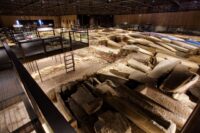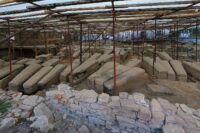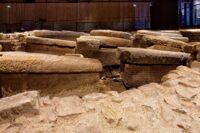 A vast Merovingian-era cemetery with more than 150 heavy lidded stone sarcophagi has gone on display in a new exhibition center built around the archaeological site in Luxeuil-les-Bains. The concentration of well-preserved stone sarcophagi is unique in eastern France, and in terms of area and density of remains, this is one of the largest and most important Merovingian sites in Europe.
A vast Merovingian-era cemetery with more than 150 heavy lidded stone sarcophagi has gone on display in a new exhibition center built around the archaeological site in Luxeuil-les-Bains. The concentration of well-preserved stone sarcophagi is unique in eastern France, and in terms of area and density of remains, this is one of the largest and most important Merovingian sites in Europe.
The Gallo-Roman city of Luxovium grew over a 2nd century B.C. Gallic sanctuary to its namesake deity Luxovius. Hundreds of Gallic votive statuettes and dedications to Luxovius and his associated goddress Brixta have been discovered. The town at the foot of the Vosges was known for its hot springs, and the 1st century bathhouse became the heart of a prosperous spa district. Roman Luxovium was devastated by Attila’s forces in 451, but while the town was, according to a 7th hagiography, a vegetation-choked ruin, the thermal baths were still very much in working order and still in use in 590 when Saint Columbanus had a monastery built there as a permanent home for his community.
 The site preserved in the new museum was first discovered during a preventative archaeology excavation carried out in 2008-2009. Out of the old parking lot in the center of town, archaeological material from 2,000 years of history emerged, with the oldest remains from a 2nd century domus. The domus was abandoned in the early 4th century and reused as a pagan necropolis. A large early Christian funerary basilica, Saint-Martin, was built at the Abbey in the 5th-6th centuries. The entire church, including the sanctuary, was used for burials. About 350 burials have been unearthed in total, including the 150 stone sarcophagi. One crypt with elaborate vaulting was built in the 670s as the final resting place of Saint Valbert, third abbot of the monastery. His remains were translated as relics all over Europe, so there’s nothing much of Saint Valbert left in Saint Valbert’s crypt, but it attests to how sacred and important a space Saint-Martin was considered to be.
The site preserved in the new museum was first discovered during a preventative archaeology excavation carried out in 2008-2009. Out of the old parking lot in the center of town, archaeological material from 2,000 years of history emerged, with the oldest remains from a 2nd century domus. The domus was abandoned in the early 4th century and reused as a pagan necropolis. A large early Christian funerary basilica, Saint-Martin, was built at the Abbey in the 5th-6th centuries. The entire church, including the sanctuary, was used for burials. About 350 burials have been unearthed in total, including the 150 stone sarcophagi. One crypt with elaborate vaulting was built in the 670s as the final resting place of Saint Valbert, third abbot of the monastery. His remains were translated as relics all over Europe, so there’s nothing much of Saint Valbert left in Saint Valbert’s crypt, but it attests to how sacred and important a space Saint-Martin was considered to be.
 The church was rebuilt in the early 9th century and major modifications altered its architectural character beyond recognition. Saint-Martin evolved from monastic church to parish church in the 12th-13th centuries. It was demolished in 1797 during the dissolutions of the French Revolution. Today the foundations of the church are visible around the dense population of sarcophagi.
The church was rebuilt in the early 9th century and major modifications altered its architectural character beyond recognition. Saint-Martin evolved from monastic church to parish church in the 12th-13th centuries. It was demolished in 1797 during the dissolutions of the French Revolution. Today the foundations of the church are visible around the dense population of sarcophagi.
Dubbed L’Ecclesia, the new exhibition center was designed by architect Michel Malcotti with a suspended metal framework that allows visitors to explore walkways and stations throughout the site without a single pillar obscuring the landscape.
Each station has a theme that explains the remains of the Saint-Martin archaeological site :
- The Saint-Martin site
- The funeral basilica and methods of burial
- The crypt of Saint Valbert
- Ancient habitat
- The late phases of the Saint-Martin church
A play of light stages these discoveries, drawing attention to details such as an inscription, a sarcophagus cover, a decoration, wells… The whole is accompanied by explanations in the form of reconstructions, 3D animations, plans, models, films, windows, to fully live this experience.
Extend your visit with the in-depth gallery, opening both on the remains and on the heritage of the city . A real link between the styles and eras of this rich heritage. This space details Irish monasticism, the Frankish world and the influence of Luxeuil Abbey, which was one of the most powerful in Europe.
No mention of any remains in the sarcophagi, if any exist. If the sarcophagi are empty I wonder when they were removed. Possibly during the 18th century dissolution and razing?
I am wondering about remains, too. The sarcophagi looks so perfect. I can’t help wanting to know if there are bodies in them. Maybe I’m morbid!
As to what –could– have once been in those sarcophagi:
What was believed to be Frankish queen Aregund’s a.k.a. Arnegunde’s coffin from 570AD was discovered in 1959 in St Denis with others.
—-
“The deceased wore a violet silk dress, secured by a belt, adorned with a buckle-plate. Her tunic, decorated with golden embroidered braid trim, was attached by a pair of fibulae decorated with garnets. Her hosiery was held up with garters and the straps lacing her shoes were fitted with small buckle-plates, plywood and belts with animal motifs. The queen, identified thanks to an inscription on her insignia ring.”
—-